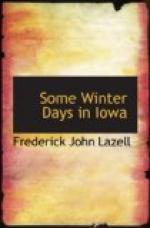The “rounded billows fixed” are the paha ridges which the glaciers made. They are not high enough to obstruct the view, nor to mar its ocean-like effect. In the middle distance you may see a farm windmill from sail to platform, but away across the snow-plain sea you catch only the uppermost part of the white sails. The rest is concealed from view by the illusory rise of the foreground toward the horizon—for this twenty-mile stretch of prairie has an illusory curve similar to that seen from all ocean shores. But now the sun has disappeared and the windmills, houses, groves, and fences which looked like black etchings against the flame-colored sky slowly vanish, first far away toward the bluffs on the yon shore of the prairie sea, then nearer, nearer, comes the gloom until the fence across the first field is scarcely discernible. The bright vermilion fades at length to misty gray and lights appear in the windows of the farm homes.
* * * * *
This sunset and twilight scene, peculiar to Iowa, is succeeded by the pageant of the stars. These are not peculiar, in neighboring latitudes, to any clime or time. They are the same stars which sang together when the foundations of the earth were fastened; the same calm stars upon which Adam gazed in remorse, the night he was driven from the garden of Eden. The Chinese, the Chaldeans, the Egyptians, the Hebrews, the Greeks, the Romans counted the hours of the night by the revolutions of the Greater and the Lesser Bear around Polaris, and guided their crafts and caravans by that sure star’s light:
"And therefore
bards of old,
Sages and hermits of the solemn
wood,
Did in thy beams
behold
That bright eternal beacon,
by whose ray
The voyager of time should
shape his needful way."
These
"Constellations of the
early night
That sparkled brighter as
the twilight died
And made the darkness
glorious"
were mysteries to Ptolemy and to Plato, as well as to Job. All ages of mankind must have watched and wondered, pondering over the unsolved problems. When the First Great Cause projected all these whirling fire-mists into illimitable space with all the laws of physics, chemistry, evolution in perfect working order, did he choose this earth as humanity’s only home? Is this the only planet with a plan of salvation? Is this mere speck among all the myriads of worlds in the solar system, and the other systems, the only creation of His hand which has known a Garden of Eden, a Bethlehem, and a Calvary? When the sun has lost his heat and the cold crystals of the earth have fought their last fight with cellular structures, and won; when all the fairy forms of field and forest are only fossils in the grim, gray rocks; when the music of bee and bird and breeze shall have waned into everlasting silence; when “all the pomp of yesterday is one with Nineveh and Tyre;”




